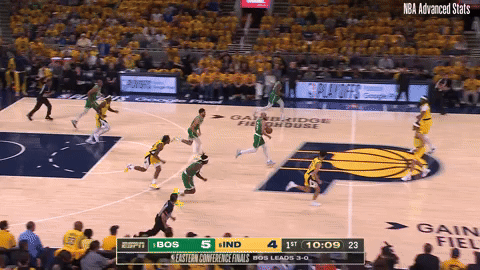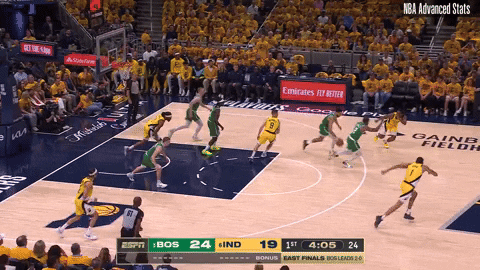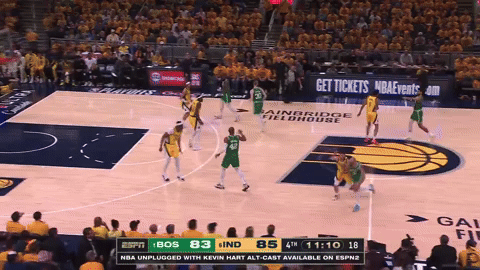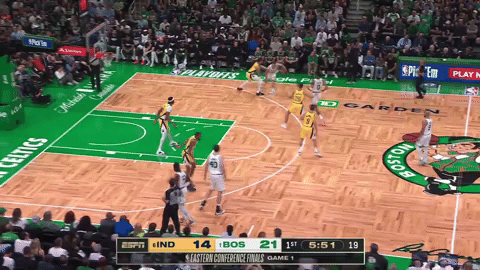Tatum overcame a tough challenge vs. Pacers
Aaron Nesmith turned out to be a difficult matchup for Jayson Tatum
Jayson Tatum is a top-5, maybe top-10 player in the NBA. He’s heading to his second NBA Finals. Against the Indiana Pacers, he was playing in his fifth Eastern Conference finals. At this stage of his career development, his learning experiences will be nuanced. They will be related to managing games, finding reads, or dictating tempo.
Tatum’s skillset will continue to improve. He will add more moves and ideas to his ‘bag,’ he will undoubtedly work out whatever kinks are hurting his perimeter jump shot. What I doubt any of us expected, though, is that he may look back at his matchup with Aaron Nesmith for ideas on where he needs to improve — or add to — his game.
Nesmith gave Tatum the business during their four-game battle. The former Boston Celtics wing found ways to take the St. Louis native out of his comfort zone. He made life tough; he took away space, he got physical, and he used his speed to take Tatum away from his personal pace.
Throughout the conference finals, Nesmith was Tatum’s primary defender. For most, that would be a daunting task. We’ve all seen what Tatum can do and how he’s liable to go Supernova without warning. Nesmith has seen it all before. He spent 18 months guarding Tatum during practice. Learning from him and Jaylen Brown. Now, in his fourth year in the NBA, Nesmith is a vastly improved player and clearly wanted to show off his improvements.
Nesmith guarded Tatum for a total of 32 minutes and 57 seconds during the conference finals. That’s 12 minutes shy of one full game. We can also calculate it as 153.2 partial possessions. During that time, Tatum took just 25 field goal attempts. He made 9 of them.
For reference, Tatum took a total of 95 shots during the conference finals. Nesmith guarded roughly 1-in-4 of those attempts. Over the four games, Tatum shot 46.3% from the field and 30.6% from three-point range.
When guarded by Nesmith, those numbers dropped to 36% from the field and 12.5% from deep.
The above clip is a good example of how Nesmith kept pace with Tatum on cuts. Staying locked to his hip and using his size and length to contest shots. Nesmith allowed his All-Star counterpart no breathing room. Tatum found himself battling on every shot attempt, regardless of where they were coming from on the floor.
An interesting point to note is that six of Tatum’s made shots against Nesmith came in game three. His approach was different. He embraced the physicality Nesmith was bringing to the table and opted to overpower him.
You will notice that the difference between the two plays is that Tatum uses his shoulder to bump Nesmith off course as he drives to the rim. Creating separation forces Nesmith to try and recover, limiting his efficiency at impacting Tatum’s shot or shot release.
Most of Tatum’s buckets against Nesmith came in a similar fashion. Why? Because when he commits to playing through contact and initiating bump-offs with his broad shoulders, he’s almost unguardable getting downhill. Nesmith’s impact came when Tatum was moving without the ball or was spotting up on the perimeter.
You may wonder why I’m diving into this specific matchup and why Nesmith has received a decent amount of praise thus far.
Nesmith worked his ass off keeping Tatum subdued — that deserves praise
It’s rare we see a defender put the clamps on Tatum
There’s a learning experience here
Other teams will look at how Nesmith guarded Tatum and believe they’ve found a blueprint. If you have an athletic and physical wing, send him Tatum’s way in the halfcourt. Don’t give him room to breathe off the catch. And live with the buckets he gets when charging the lane or running in transition.
The key for Tatum, when being guarded this closely, is to embrace working off the ball. Pass the rock and cut. Attack off stampede actions. Flow into a post-up, where we all know he’s incredibly comfortable. Or, create contact early to create space before turning the jets on.
Nesmith is a tough defender. He plays with pride, energy and a youthful exuberance that doesn’t know when he should be beaten. That doesn’t mean he’s a better defender than Tatum is an offensive player. Nor does it mean he’s got Tatum’s number. It just means that he found a way to limit the opposing team's best player based on the system they were running and due to his struggles on the perimeter.
Give Nesmith his flowers. But don’t let this fool you — Tatum still found ways to dominate throughout the series and will be a big threat during the NBA Finals.
The Celtics Chronicle is a reader-supported publication. To receive new posts and support my work, consider becoming a free or paid subscriber.
Empty corner duck-ins
One way the Celtics looked to counter the Pacers’ defense on Tatum was by asking him to work as a screener in empty-side actions before ducking into a post-up. The idea was that Tatum’s screen would force a switch, giving him a mismatch to exploit.
This is a possession from Game 3. The Celtics are trailing by two. The Pacers have pressured the ball in a press. Rather than trying to attack a half-court action, they flow into an empty-side PnR between Tatum and White. The caveat here is something the Celtics have displayed throughout the conference finals — Tatum doesn’t make a play to directly roll to the rim, nor does he look to pop into the corner. Instead, he ducks into a post-up position to seal his defender before rolling as the entry pass is made.
The result is a clean look around the rim.
Boston has run variations of this empty-side duck-in throughout the series. Let’s take a look at a couple of others.
In the same situation, Tatum sets the screen and ducks into a post-up to punish the mismatch. He has a size advantage over TJ McConnell, so he opts to shoot a turn-around jumper right over his man. That mid-post area on the right side of the court is one of Tatum’s spots. If he has a clear look at the rim and doesn’t have the size or length to bother him on the shot, he’s going to be money from there more often than not.
Ok, let’s do one more.
Slight variation in this one, but still the same principle. The Celtics get into their empty-side action with Tatum as the screener. Pritchard slightly drags the dribble to draw his defender and create a passing angle. A pocket pass sets Tatum up for a stampede cut directly at the rim, where he draws contact and gets the foul.
Little tweaks to the offense like this can be a great way to relieve a player from the defensive pressure an opponent throws at them. It wouldn’t matter if Nesmith was guarding Tatum to begin these actions because the concept of forcing the switch would have nullified Nesmith’s presence.
That’s why…
You see the Celtics hunting mismatches so frequently. Yes, it’s the path of least resistance. And yes, it’s a part of the modern NBA. Yet, Joe Mazzulla has his team doing it because it presents the defense with a smorgasbord of problems. Do you send two at Tatum when he ducks in? Do you blitz White as he comes off the screen and looks to turn the corner? Do you send help? If so, from where?
What else are you meant to do when you have mismatched advantages at every position? It would be malpractice not to attack those opportunities. The key is hunting them at the right times and not falling into the trap of hunting them on every possession. At times, the Celtics can slip into that trap, but for the most part, they flow into mismatch possessions within the rhythm of the game — Tatum’s empty-side duck-ins being a prime example.
Today’s the day…Maybe…I mean, it could be…
Today is the day, or at least could be the day, where we find out who the Celtics will face in the NBA Finals. If we’re being honest, it’s a poorly kept secret. The Minnesota Timberwolves must be perfect for another three games if they want to overcome the Dallas Mavericks and book their spot vs the Celtics.
Three perfect conference finals performances. It’s a tough ask. It's not impossible, but it's very tough. I can’t see it. Maybe Minnesota will win tonight. Maybe the find a way of forcing a game 7. However, I doubt it goes that far. If Dereck Lively II is fit to play (he’s questionable heading into the day) and is even at around 80% of his usual self, the Mavericks will probably seal the deal.
Of course, it helps that Maxi Kleber is back in Dallas’ rotation, too. He’s their most versatile frontcourt defender and gives them some additional insurance if Lively isn’t at his best.
For Celtics fans, the only advantage of this series ending early is that we know who the team will face in the Finals. The NBA isn’t bringing that series's start date forward, so it doesn’t shorten the wait. In truth, the longer this series can go on, the better. Let the Celtics get some additional rest. Give them more time on the practice court and in the film room. And let these two Western Conference foes beat each other into submission.
You’ve got to welcome your advantages wherever and however they come, right?
I’d like to say that I’ll be tuning in and watching the game closely tonight, but that would be a lie. The truth is that I’ll be fast asleep, with no ounce of worry about how the result shakes out. I’m confident in this Celtics team. And I’m looking forward to diving into the scouting report.
Show some love…
To the YouTube page. It’s still young, and I’m still figuring out how I want the content on there to look, but it would be great to see an influx of subscribers — especially from this newsletter as I aim to supplement content here with more thoughts over there and vice versa.
Here’s a link to a quick 10 minute video that dropped this morning. As usual, I appreciate you all for rocking with me, and will catch you here tomorrow.






